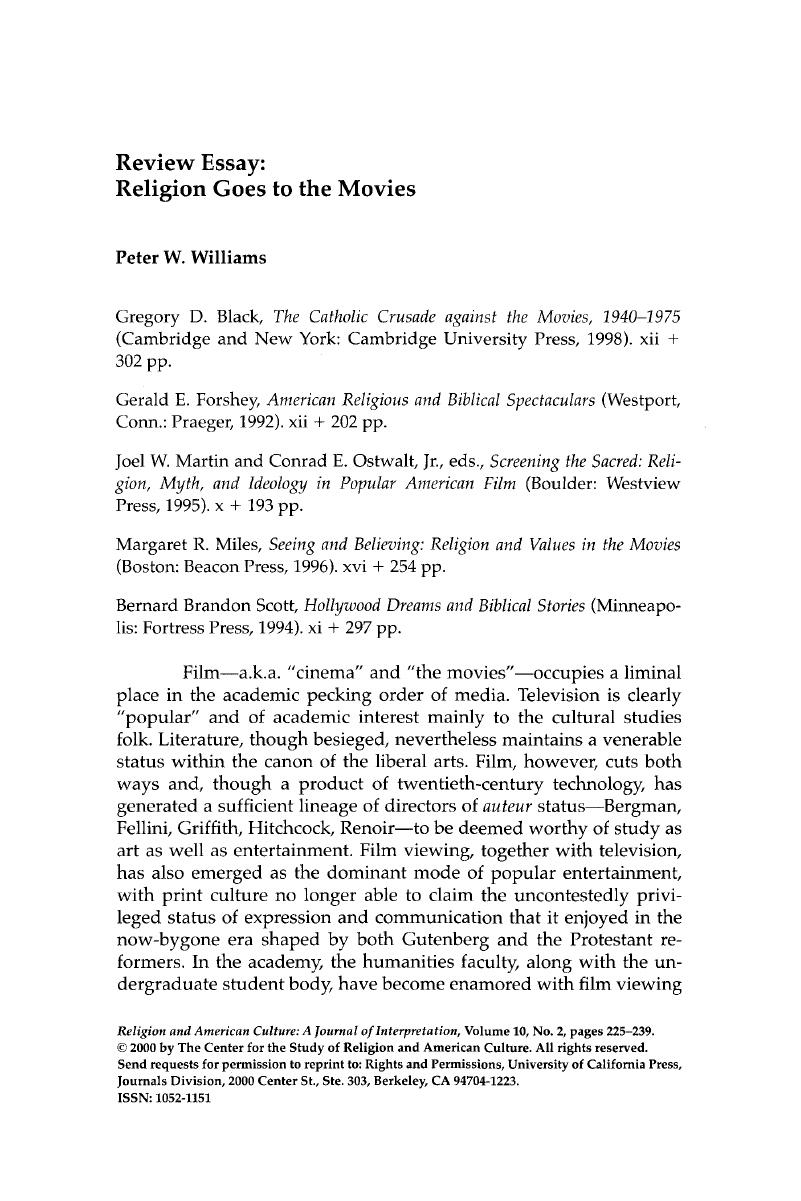Article contents
Review Essay: Religion Goes to the Movies
Published online by Cambridge University Press: 18 June 2018
Abstract

- Type
- Review Article
- Information
- Copyright
- Copyright © Center for the Study of Religion and American Culture 2000
References
Notes
1. For a somewhat different take on several of these same works, see Mark Hulsether, “Sorting Out the Relationships among Christian Values, US Popular Religion, and Hollywood Films,” Religious Studies Review 25, no. 1 (January 1999): 3-11 (with extensive bibliography).
2. Miles, Seeing and Believing, 6.
3. Les, and Keyser, Barbara, Hollywood and the Catholic Church: The Image of Roman Catholicism in American Movies (Chicago: Loyola University Press, 1984), 2 Google Scholar.
4. Martin and Ostwalt, Screening the Sacred, 155.
5. See J. Hoberman, “When the Spiee of Choice Was Sin,” New York Times, August 15, 1999, Arts and Entertainment section, 9, 18.
6. See also, e.g., Facey, Paul W., The Legion of Decency: A Sociological Analysis of the Emergence and Development of a Social Pressure Group (New York: Arno Press, 1974)Google Scholar; and Walsh, Frank, Sin and Censorship: The Catholic Church and the Motion Picture Industry (New Haven: Yale University Press, 1996)Google Scholar.
7. Keyser, Hollywood and the Catholic Church, 62.
8. Morris, Charles R., American Catholic: The Saints and Sinners Who Built America 's Most Powerful Church (New York: Random House/Times Books, 1997)Google Scholar, chap. 8.
9. Keyser, Hollywood and the Catholic Church, 97. See also Kane, Paula M., “American Catholic Culture in the Twentieth Century,” in Perspectives on American Religion and Culture, ed. Williams, Peter W. (Maiden, Mass., and Oxford, U.K.: Blackwell, 1999), 400–401 Google Scholar.
10. See May, John R., “The Godfather Films,” in Image and Likeness: Religious Visions in American Film Classics, ed. May, John R. (New York: Paulist Press, 1992), 68–69 Google Scholar.
11. Erens, Patricia, The Jew in American Cinema (Bloomington: Indiana University Press, 1984), 33–42 Google Scholar. Erens provides a thorough chronicle and set of plot summaries of Jewish themes in American film, as does Friedman, Lester D., Hollywood's Image of the Jew (New York: Ungar, 1982)Google Scholar. Either book may profitably be read in parallel with Keyser, Hollywood and the Catholic Church.
12. Erens, The Jew in American Cinema, 91, 102, 135.
13. Ibid., 177.
14. Ibid., 255, 286, and passim.
15. Ibid., 276.
16. Walter Goodman, “Survival of the Fittest, in Hollywood and the Heartland,” New York Times, August 25, 1999, B2.
17. See Balmer, Randall, Mine Eyes Have Seen the Glory: A Journey into the Evangelical Subculture in America (New York: Oxford University Press, 1989)Google Scholar, chap. 3.
18. Forshey, American Religious and Biblical Spectaculars, 127.
19. Ibid., 4.
20. Ibid., 5-7 and passim.
21. Ibid., 13.
22. Ibid., 125,131.
23. Ibid., 128.
24. Ibid., 130-31.
25. May, ed., Image and Likeness, 119,156.
26. Scott, Hollywood Dreams and Biblical Stories, 283.
27. See Kaminsky, Stuart M., American Film Genres, 2d ed. (Chicago: Nelson-Hall, 1985)Google Scholar, for a useful introduction to genre theory in the American context.
28. Scott, Hollywood Dreams and Biblical Stories, 11-13.
29. Ibid., chap. 3.
30. Miles, Seeing and Believing, 147,155.
31. Ibid., 191.
32. Ibid., 192.
33. May, John R. and Bird, Michael, eds., Religion in Film (Knoxville: University of Tennessee Press, 1982)Google Scholar. Bird's introductory essay, “Film as Hierophany,” is something of a classic of its kind.
34. Joel W. Martin, “Redeeming America: Rocky as Ritual Racial Drama,’ in Screening the Sacred, ed. Martin and Ostwalt, 128.
35. For example, Screening the Sacred, ed. Martin and Oswalt, vii and 158.
36. Anthony Lane, “Star Bores,” New Yorker, May 24,1999, 84.
37. For some general books on film and film in the United States, see: Monaco, James, How to Read a Film: The Art, Technology, Language, History, and Theory of Film and Media (New York: Oxford University Press, 1981)Google Scholar; May, Lary, Screening Out the Fast: The Birth of Mass Culture and the Motion Picture Industry (New York: Oxford University Press, 1980)Google Scholar; and Sklar, Robert, Movie Made America: A Cultural History of American Movies (New York: Vintage, 1994)Google Scholar.
- 2
- Cited by


